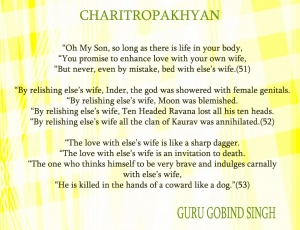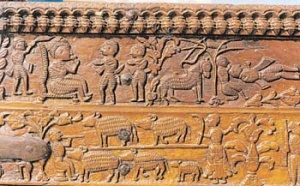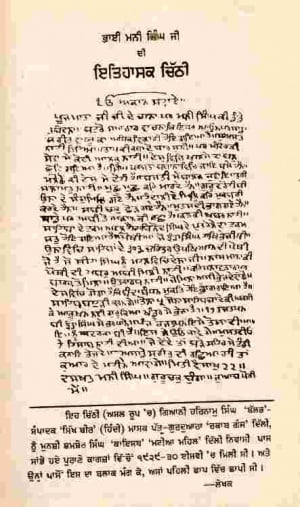Charitropakhyan: Difference between revisions
No edit summary |
No edit summary |
||
| Line 70: | Line 70: | ||
The composition commonly referred to as 'Chaupee Sahib' amongst mainstream Sikhs is actually the conclusion to the 'Treh Charittar'. | The composition commonly referred to as 'Chaupee Sahib' amongst mainstream Sikhs is actually the conclusion to the 'Treh Charittar'. | ||
==False Claims== | |||
The claim by the S.G.P.C. and other Sikhs of such narrow-minded puritanical thinking (too many groups to mention), that these beautiful and timeless stories are derived of 'Hindu' mythology is opinion born of complete stupidity, ignorance, paranoia, insecurity and extreme fanaticism. | |||
Should the recommendation of the S.G.P.C. be put into practice by the masses, and accepted as 'Hukam' (law), the result would be:<br> | Should the recommendation of the S.G.P.C. be put into practice by the masses, and accepted as 'Hukam' (law), the result would be:<br> | ||
Revision as of 06:58, 23 August 2009

CHRITROPAKHYANalso called Triya Charitar, is a long composition comprising women's tales in verse which forms over one third of the Dasam Granth, having 404 distinct chapters. The work is generally ascribed to Guru Gobind Singh. A school of opinion, however, exists which asserts that Chritropakhyan and some other compositions included in the Dasam Granth are not by the Guru but by poets in attendance on him. What is clear is that most of 404 tales give a moral message rather than a historic message.
History
According to the date given in the last Chritra or narrative, this work was completed in 1753 Bk/AD 1696 on the bank of the River Sutlej, probably at Anandpur. The last tale in the series is numbered 405, but number 325 is somehow missing. The tales centre upon the theme of women's deceits and wiles, though there are some which describe the heroic and virtuous deeds of both men and women.
Chariters arise from foreign sources, personal experiences of the Tenth Guru and others miscellaneous sources. Many scandalous stories floating about the society of the time, imaginary stories, urban legends etc., also found their way into Triya Chrittar. In some cases, multiple tales are mishmashed together to produce a wonderful new concoction of stories.
The various tales
The chapters are of wondrous variety, being sensual, romantic, humourous, philosophical, valiant and entertaining. Many stories also deal with the darker side of human nature, such as incest, magic of myth, the mystical nature of legend, homosexuality, adultery, etc. These stories were collected from Punjabi folklore, Indian folklore and classical traditional texts.
Some of these stories are spread over several chapters such as those of 'Anup Kaur' which is spread over chapters 21,22 and 23. These stories though predominately dealing with wiles of women.
Tale one is a long introductory composition. It opens with an invocation to weapons, or to the God of weapons; then a number of Hindu mythical characters appear, and a terrific battle between the demons and the gods follows. Finally Chandi appears, riding on her tiger, and her enemies "fade away as stars before the rising sun." With a final prayer for help and forgiveness the introductory tale ends. In the last Tale 405 again the demons and gods battle. When Chandi is hard pressed, the Timeless One finishes off the demons by sending down diseases upon them.
Tale two tells how the wise adviser to Raja (king) Chitra Singh related these tales of the wiles of women in order to save his handsome son Hanuvant from the false accusations of one of the younger ranis (queens). Some of these tales were taken from old Hindu books such as the Mahabharata, the Ramayana, the Puranas, the Hitopadesa, the Panchatantra, from Mughal family stories, from folk tales of Rajputana and the Punjab, and even from ancient Hebrew lore.
They also arise from foreign sources, personal experiences of the Tenth Guru and others miscellaneous sources. Many scandalous stories floating about the society of the time, imaginary stories, urban legends etc., also found their way into Treh Chrittar. In some cases, multiple tales are mishmashed together to produce a wonderful new concoction of stories.
The composition commonly referred to as 'Chaupee Sahib' amongst mainstream Sikhs is actually the conclusion to the Triya Charitar.
The underlying message
Acc to Bhai Mani Singh in Bhagat Mala has said, "Charitar acts as a warning so that the devout do not get trapped in women's intrigues and machinations
The moral they aim at is that one should not become entangled in the intrigues of wily women by becoming a slave to lust, for trusting them is dangerous. This does not mean that it is wrong to trust one's own wife, or worthy women ; but that it is fatal to lose this world and the next by becoming enamoured of strange women and entrapped in their wiles.
The theme of most of the tales, however, is that many women will stop at nothing slander, arson, murder to obtain their heart's desire; that men are helpless in their clutches; and that if men spurn them they have to reckon with the vilest and deadliest of enemies; but that, conversely, worthy women are the staunchest of allies, and think nothing of sacrificing their lives for their beloved.
Tales with moral messages
In the Dasam Granth a title is given at the end of each tale. Thirty two of a total of 404 Tales are thus labelled "Tales of Intrigue." The remaining 372 Tales are labelled as "The Wiles of Women." However, while most of these are about lustful, deceitful women, there are some 74 tales of the bravery and intelligence of women, such as Tale 102 where Ram Kaikeyi drives Raja Dasaratha into battle when his charioteer is killed; or Tale 137 where Draupadi rescues the unconscious Arjun and puts his enemies to flight. Men come in for at least a small share of being deceivers. In this mixture of tales of various sorts, there are ten "moral stories" of the folly of gambling, drinking, and opium eating.
There are also folk tales; love stories of Krisna and Radha; of Krsna and Rukmini; of Aurarigzeb's sister (Tale 278); and of Joseph and Zulaikha, based on the Biblical story of Joseph and Potiphar's wife in Genesis.
The closing verses of Tale 405 have some lofty teaching about the Timeless Creator, His understanding love, and ends with a plea for His continuing protection. Verses of gratitude for help in completing the composition form the final prayer of the author and close this strange mixture of the tales of intrigue, of women mostly, some worthy, many sinful, in which men are often pictured as the gullible tools of these enchantresses.
Akali Baba Mohinder Singh States "‘If we travell a road in which are dangerous potholes.Is it not wisdom to be aware of them and thus avoid them? Treh Chrittar forewarn the Khalsa of the potholes we encounter in daily life. They warn us of all the evil consequences of lust, blind rage, greed, vices etc.’"
Bhai Mani Singh's letter
Historic letter addressed by him from Amritsar to Mata Sundari Ji (the wife of Guru Gobind Singh Ji) at Delhi in April 1716 mentioning chritropahyan.
Letter of Bhai Mani Singh to Mata Sundari Ji
May the Almighty help us.
Mani Singh makes his humble prostration at the holy feet of his venerable mother. Further news is that the climate of this place has aggravated my rheumatism and my health deteriorates fast. I will have to listen to the healing parable of the tertian fever. But my illness has caused no slackness in the performance of the holy service of the Hari Mandir (Golden Temple). The Khalsa no more hods away over the country and its power has waned. The Sikhs have migrated to the mountain retreats. The Malechhas reign supreme in the country. There is no security for the (Sikh) children and women in any habitation. They are hunted out and killed. The opposing states have also joined hands with them. The Hindalis spy on the Sikhs. All (the Sikhs) have deserted the Chak (The earliest name of Amritsar). The Mutsaddis (priests) have also fled. So far the Immortal Lord protects me. Tomorrow is uncertain. What is ordained by the Lord shall prevail. The adopted son of Binod Singh has passed away. Among the books I sent per Jhanda Singh, there is one entitled "303 Chritra Upakhyans" by the Lord (Guru Gobind Singh). Give that to Sihan Singh in the Mahal (Matia Mahal in the interior of Delhi City). So far there is no trace of the book "Nam Mala". I found the first part of "Krishna Avtar" but not the second. I shall send it when available. There is a rumour in the country that Banda (Bahadur) has made his good escape from the Emperor's jail. May the Guru protect him. The Guru's family (the descendants of the Guru) at Khandur have sent five tolas of gold as a gift for your son's bride(an adopted son of Mata Ji, as all of her four sons were martyred already). Recover seventeen rupees from Jhanda Singh ; I gave him five rupees to meet the expenses of the journey…(?) These expenses will be incurred by him. The Mutsaddis have not yet settled accounts, otherwise I would have sent a draft from the city (presumably Lahore) . If my health improves I shall come in the month of assu.
Baisakh 22
Signed- Mani Singh,
Guruchak, Bunga
P.S. Reply in bamboo stick. (as being confidential)
Criticism
In the early 1970s, Santokh Singh (a Sikh scholar) from Chandigarh wrote a letter to the Shromani Gurudwara Parbandak Committee (S.G.P.C.) quering the authenticity of the Dasam Granth as being of Guru Gobind Singh ji's hand.
On 3rd August 1973, he received a reply from the S.G.P.C stating:‘Chritter Pkhyan which are entered in the Dasam Granth, they are not the work of Guru Gobind Singh. They are ancient mythological stories of Hinduism.’(‘Dasam Granth Bareh Chonveh Lekh’ by Principle Harbhajan Singh, P.122-123)
The above reply was sanctioned by the then S.G.P.C. Jathedar (commander) of the Akal Takht, Sadhu Singh Bhaura, Chet Singh (Head Granthi of Golden Temple), Kirpal Singh Granthi and Sohan Singh (Granthi of Golden Temple).
Yet these same individuals did not take into consideration that within their daily liturgy of prayers, and, within the Khalsa initiation ceremony, they actualy employ scripture from Treh Chritter ('Kabio Bach Benanti Chaupee Sahib').
The composition commonly referred to as 'Chaupee Sahib' amongst mainstream Sikhs is actually the conclusion to the 'Treh Charittar'.
False Claims
The claim by the S.G.P.C. and other Sikhs of such narrow-minded puritanical thinking (too many groups to mention), that these beautiful and timeless stories are derived of 'Hindu' mythology is opinion born of complete stupidity, ignorance, paranoia, insecurity and extreme fanaticism.
Should the recommendation of the S.G.P.C. be put into practice by the masses, and accepted as 'Hukam' (law), the result would be:
- ALL rehitnaamas (attributed to the warriors of Akali Nihang Guru Gobind Singh ji) would be invalid
- The 'Amrit Sanchar' (initiation of new warriors into the Khalsa) would be invalid
- 'Rehras Sahib' as recited by ALL Sikhs every evening would be invalid
- The 'Ardas' would be invalid
- Over 300 years of documented history would be seen as false
- The knowledge of mighty Sikhs such as Akali Nihang Baba Deep Singh Ji Shaheed, Bhai Mani Singh Ji Shaheed, Akali Nihang Baba Binod Singh Ji, Akali Nihang Baba Durbara Singh, Akali Nihang Baba Phoola Singh Ji, Akali Nihang Jassa Singh Ahluwalia, Akali Nihang Jassa Singh Ramgharia, Akali Nihang Baba Kapur Singh, Baba Gurbachan Singh Bhindrawaleh who ALL acknowledged Dasam Guru Durbar would be considered as being false
See also
References
- Dharam Pal Ashta, The Poetry of the Dasam Granth. Delhi, 1959
- C.H. Loehlin, The Granth of Guru Gobind Singh and the Khalsa Brotherhood. Lucknow, 1971
- Ratan Singh Jaggi, Dasam Granth Parichaya. Delhi, 1990
External Links
- See Charitropkhyan in the handwriting of Guru Gobind Singh www.sridasamgrabnth.com Gallery ection
- English translation of Chritropakhyaan
- www.tribuneindia.com
- English Translation of Chritropakhyaan From Dasam Granth Vol-1
- English Translation of Chritropakhyaan From Dasam Granth Vol-2
- Sant Singh Maskeen on charitropakhyan
- http://www.sarbloh.info
| Banis: | Jaap | Akal Ustat | Bachitar Natak | Chandi Charitar Ukat(i) Bilas | Chandi Charitar 2 | | Chandi di Var | Gyan Parbodh | Chobis Avatar | Brahm Avtar | Rudar Avtar | Shabad Hazarey | 33 Swaiyey | Swayyae| Shastar Nam Mala | Charitropakhyan | Zafarnama | Hikayats |
| History: | Historical References · Guru Gobind Singh · Paonta Sahib · Bhai Mani Singh · Mata Sundri |
| Philosphy: | Idol Worship · Pilgrimages · Chandi · Triya · Shastar · Waheguru |
| Sikh Scholars About Dasam Bani: | Singh Sabha Lahore · Bhai Kahn Singh Nabha · Professor Sahib Singh · Bhai Veer Singh · Jarnail Singh Bhindrawale · Anti Dasam Bani Movement |


